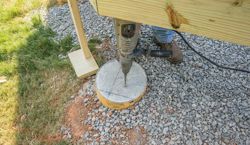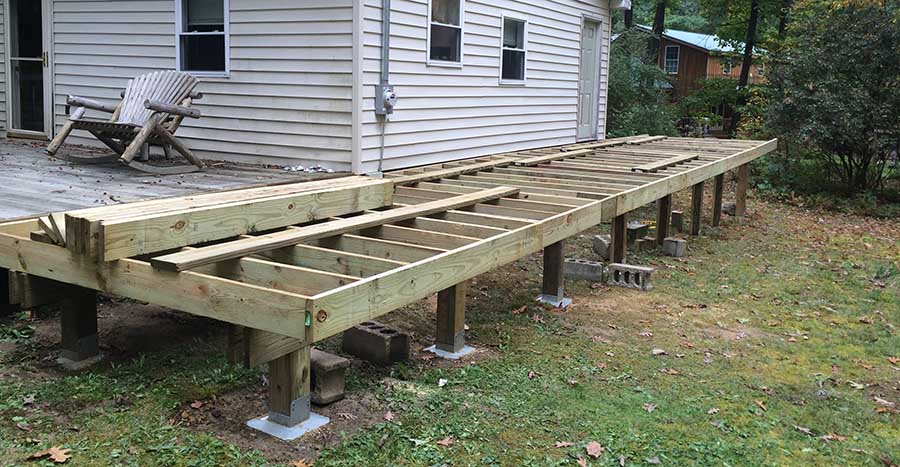Deck Footings Demystified: Your Plan for a Safe, Durable Outdoor Place
Choosing the Right Deck Footings for Security and Durability
The durability and safety and security of your deck depend heavily on the type of grounds you select, as they supply the important assistance and security to endure the test of time. In this discussion, we will certainly discover the various types of deck grounds, think about the vital factors to evaluate when making a choice, and dive into the pros and disadvantages of various options.
Sorts Of Deck Footings
These grounds are composed of a round opening filled up with concrete, which supplies a strong structure for the deck posts. Concrete pier footings are reasonably easy to install and use superb security, making them a preferred selection for several deck projects.
One more kind of footing is the helical pile ground. Helical heaps are steel shafts with helical plates connected to them. These footings are set up by screwing them into the ground, which develops a protected structure for the deck. Helical pile footings are optimal for areas with challenging soil conditions, as they can be mounted in virtually any kind of kind of dirt. If required., they additionally enable for simple adjustment and progressing of the deck.
Alternatively, some contractors choose precast concrete grounds. These grounds are made of sturdy concrete and can be found in different sizes and shapes to accommodate different deck layouts. Precast concrete grounds are practical to install and provide a steady base for the deck structure.
Ultimately, one more option is the post-in-anchor ground system. This type of ground involves driving a steel anchor right into the ground and connecting it to the deck post. It uses flexibility in regards to positioning the deck blog posts and appropriates for decks with lightweight structures.
When picking the best sort of deck footing, it is necessary to consider aspects such as soil conditions, deck lots, and regional building ordinance (Deck Footings). Consulting with an expert contractor or structural designer can help make sure the suitable ground is chosen for a risk-free and secure deck
Elements to Think About When Picking Grounds
When selecting the appropriate footings for a deck, it is vital to thoroughly take into consideration various elements such as dirt conditions, deck lots, and adherence to neighborhood building ordinance. These factors play a considerable function in making certain the stability and resilience of the deck structure.
Among the key aspects to think about is the soil problems. The kind of soil on which the deck will be built determines the sort of grounds required. For circumstances, decks developed on loose or sandy soils may need deeper grounds to offer ample support and prevent settling. On the other hand, decks developed on clay or expansive dirts may call for grounds that can fit the soil's tendency to expand and agreement.
One more important factor is the deck lots. The weight of the deck, consisting of the products utilized and any potential real-time tons such as furniture or events, should be taken into consideration when picking footings. The footings must be designed to birth the weight of the deck and distribute it evenly to stop any kind of architectural issues or failings.
Lastly, adherence to neighborhood building regulations is extremely important. Building ordinance vary from region to area, why not look here and it is necessary to adhere to the specific requirements established by the local authorities. Deck Footings. These codes ensure that the deck is constructed safely and meets the required criteria for structural honesty and load-bearing capability
Concrete Grounds: Cons and pros

Concrete footings provide a number of benefits and downsides when made use of as the structure for a deck. On the positive side, concrete grounds give exceptional security and longevity.
Another benefit of concrete grounds is their adaptability. They can be put into different sizes and shapes to fit different deck styles and setups. Concrete grounds can be personalized to fit the certain requirements and requirements of the deck structure.
However, there are also some drawbacks to making use of concrete grounds. One significant disadvantage is the cost and labor involved in their installment. Concrete grounds need excavation and commonly require the aid of heavy equipment. This can boost the general cost of the deck task and may require specialist help.

Helical Piers Vs. Sonotubes: Which Is Better?
In taking into consideration the structure choices for a deck, the comparison between helical piers and sonotubes is critical in establishing the remarkable option. They are turned right into the ground making use of hydraulic equipment, supplying a steady and sturdy foundation for the deck.
When it pertains to stability and sturdiness, helical piers have the upper hand. The helical plates on the piers produce a strong grip with the dirt, shifting or protecting against any kind of motion of the deck. This is especially valuable in locations with unsteady or shifting dirt problems. Sonotubes, on the other hand, count exclusively on the concrete filling for security, which might not provide the same degree of strength and resistance.
In terms of installment, helical piers are relatively easier and faster to set up you can look here contrasted to sonotubes. The hydraulic machinery made use of to twist the piers right into the ground ensures a fast and efficient procedure. Sonotubes, on the various other hand, call for digging holes and putting concrete, which can be taxing and labor-intensive.
Furthermore, helical piers are a more functional choice. They can be made use of in numerous soil conditions and can be changed or reinforced if needed. Sonotubes, on the other hand, might call for additional assistance, such as rebar, in particular dirt conditions or areas with high tons demands.
Picking the Right Footings for Your Deck's Dimensions
For ideal architectural honesty, it is vital to meticulously pick the proper footings that align with the dimensions of your deck. The measurements of your deck, including its length, elevation, and size, play a significant function in establishing the kind and dimension of grounds needed.
When choosing grounds for your deck, it is essential to consider the load-bearing capacity of the soil. The weight of the deck, combined with check here the weight of any furnishings or individuals on it, exerts a significant force on the grounds (Deck Footings). It is critical to pick footings that can effectively sustain this weight without moving or sinking over time.
The size and form of the grounds ought to additionally be considered. Larger decks with better measurements need bigger grounds to provide enough security and assistance. The shape of the footings, whether they are rounded or square, depends upon the style and layout of the deck. In addition, the deepness at which the footings are set up ought to be identified based upon the frost line in your area to avoid any type of heaving or shifting as a result of freezing temperatures.
Verdict
In conclusion, picking the right deck grounds is essential for making certain security and resilience. Aspects such as the kind of grounds, the deck's dimensions, and the pros and disadvantages of various options should be thought about.
These footings are composed of a round opening filled with concrete, which offers a solid structure for the deck blog posts. Concrete pier grounds are reasonably simple to mount and use excellent stability, making them a popular choice for many deck projects.
Precast concrete footings are convenient to install and offer a stable base for the deck structure.
It offers flexibility in terms of positioning the deck articles and is ideal for decks with light-weight frameworks.
Concrete footings provide several advantages and drawbacks when used as the foundation for a deck.